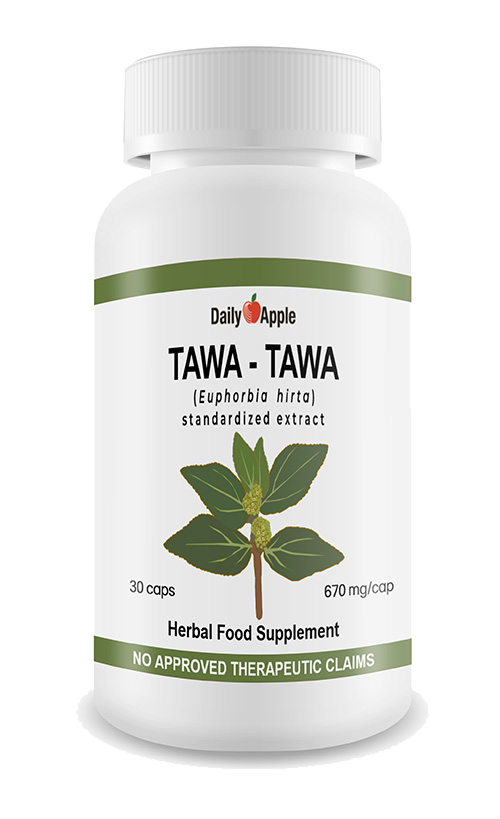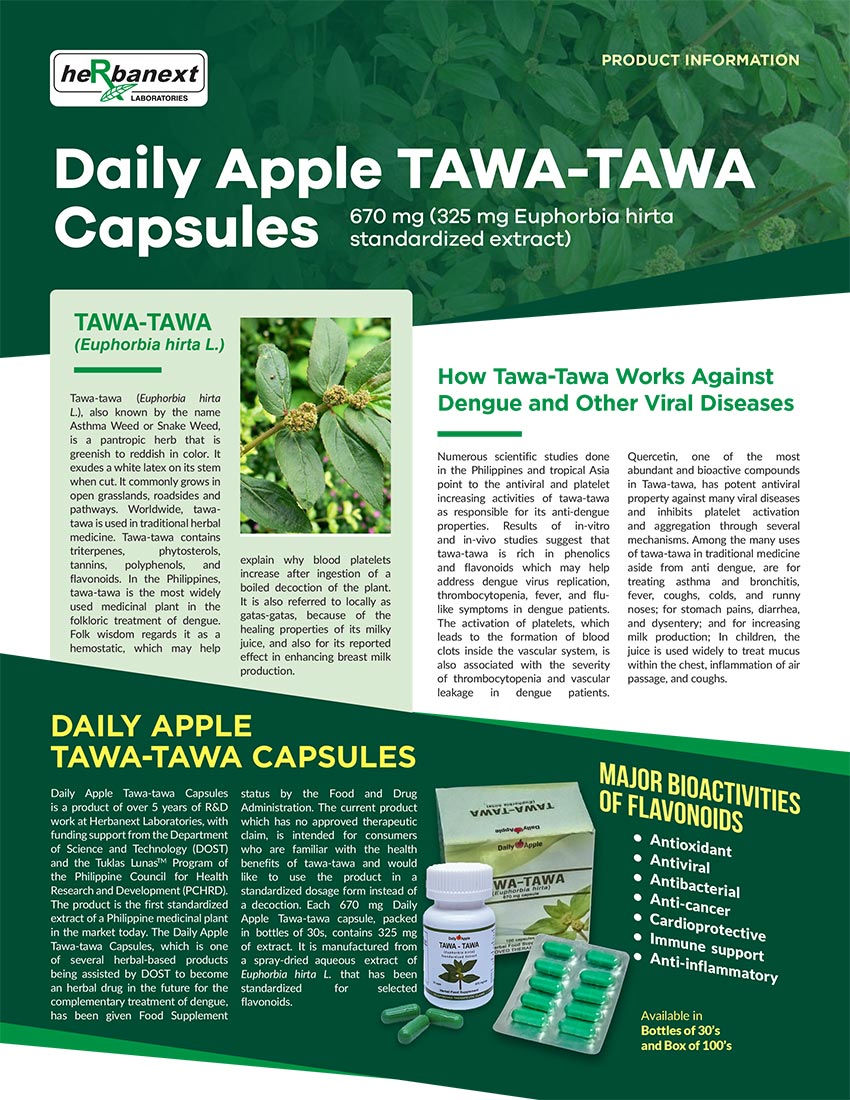SHORT REVIEW
Potential use of flavonoid-rich Euphorbia hirta L. extracts for the management of COVID-19 novel coronavirus infections
Cruz, P. A. C.1, Farol, A. N. C.1, Ynion, G. P. Q.1 & Cruz, P. S.1
1Herbanext Laboratories, Inc. , Bago City, Negros Occidental, Philippines
ABSTRACT
An increased number of infection cases coupled with a limited number of possible treatments in the light of the 2019 novel coronavirus (COVID-19) outbreak has greatly driven the demand for traditional medicine as a form of treatment or prevention of the disease. In this brief communication, we present standardized extracts of the popular Philippine medicinal herb Euphorbia hirta L. or “tawa-tawa” as a potential form of management for the disease. Although still in need of further clinical validation, the anti-viral activity noted from literature on some of the active compounds of this plant warrants enough rationale to look into its application. This is further elaborated in the overview presented by this report.
Key Words: COVID-19, coronavirus, Euphorbia hirta, tawa-tawa
INTRODUCTION
In light of the many cases of infection arising globally due to the spread of the 2019 novel coronavirus, COVID-19, an increased demand for possible formulations for the treatment or prevention of the disease is expected. Many groups are currently addressing this issue through the development of vaccines and the repurposing of existing drugs.1 Concurrently, an increase in the demand for traditional medicine has also been observed, with many consumers seeking popularly-used remedies in Traditional Chinese Medicine (TCM) as a form of prevention against the disease.2
The World Health Organization (WHO), which formally recognizes traditional medicine as a potential form of treatment, has encouraged a scientific approach to test the efficacy of these products, as well as a standardized design for all studies.1,2 Hence, a rational selection of candidates for traditional medicine is greatly warranted.
Among the numerous plants being screened for their potential activity against COVID-19, Euphorbia hirta L. shows particular promise. E. hirta, also known as tawa-tawa or gatas-gatas, is a common herb of the family Euphorbiaceae that has been used in Philippine folk medicine as a form of treatment against dengue viral infection.3 The plant grows abundantly along fields and roadsides, and has been commercialized much throughout the country by sale in the form of herbal capsules containing powdered tawa-tawa or tawa-tawa extracts.3
Much of tawa-tawa’s bioactivity has been attributed to its high content of flavonoids—compounds which have long been studied for their antiviral activity.4 This report briefly discusses the importance of several major bioactive flavonoids obtained from tawa-tawa to emphasize the rational selection of this plant as a form of traditional medicine with potential applications in the management of COVID-19.
DISCUSSION
Flavonoids are notably one of E. hirta’s most abundant chemical constituents, amounting to approximately 0.10% of the plant’s aqueous extractable fraction.5 The most abundant flavonoid, quercetin (QUE), comprises around 60% of all flavonoids in E. hirta, followed by kaempferol (KMF) at 25%, and rutin (RUT) at 15%.5 Other phenolic compounds such as gallic acid (GA), quercitrin (QTR), and myricitrin (MTR) have also been obtained from extracts of the aerial parts of E. hirta.6,7 The application of these compounds for the management and treatment of viral diseases is no nuance in itself. In silico molecular docking studies using Autodock with QUE, KMF, and GA against several types of viral proteases and replication machinery (see Table 1) have suggested the potential of these compounds as antivirals. 8
Table 1. Predicted inhibition constants (IC50) of several flavonoids from E. hirta extracts from in silico molecular docking studies using Autodock.8
| Compound | Viral Protein | IC50 (Autodock), uM |
| Quercetin | Influenza neuraminidase (1L7F)
Dengue NS2b/NS3 protease (2FOM) Chikungunya nsP2 protease (3TRK) |
2.83
6.64 2.68 |
| Kaempferol | Influenza neuraminidase (1L7F)
Dengue NS2b/NS3 protease (2FOM) Chikungunya nsP2 protease (3TRK) |
4.35
12.30 2.39 |
| Gallic acid | Dengue NS5 Methyltransferase (2P40)
HIV-1 protease (1ODY) |
23.86
4.10 |
Further testing using in vivo models for viral replication has allowed for the translation of this molecular docking data to evidence at the cellular level. For instance, one study on QUE against dengue virus type-2 (DENV-2) infected cultures of Vero cells using the Foci Forming Unit Reduction Assay (FFURA) and qRT-PCR affords an IC50 of 28.9 ug/mL for the compound.4 The antiviral activity of QUE against the hand, foot, and mouth disease-causing Picornavirus enterovirus 71 (EV71) has also been assessed in vivo by phenotype screening in human rhabdomyosarcoma (RD) cells, coupled with molecular docking studies to extrapolate the mechanism of action of the compound. The study yielded an EC50 of 12.1 uM for QUE against EV71 with low cytotoxicity (CC50 > 200 uM), and predicted that QUE works by blocking substrate recognition by binding to the EV71 3Cpro and inhibiting its activity.9
Apart from the aforementioned examples, multiple putative mechanisms of flavonoid action against viruses have been proposed, depending on the flavonoid and the virus studied. Table 2 lists a few examples of the results of several in vivo studies using flavonoids against particular viruses.
Table 2. In vivo studies on the use of QUE, KMF, and GA against some common viruses.
| Compound | Virus Assayed | Test Method | Results |
| Quercetin10 | Hepatitis C virus
|
Infection assay,
Replication assay, DGAT localization assay
|
85% reduced replication
92% reduced infectious particles, 65% reduced infectivity
|
| ,Kaempferol11 | Japanese encephalitis | MTS reduction assay using BHK21 cells
|
EC50 = 12.6 uM
CC50 = 230 uM inhibits viral replication and protein expression
|
| Gallic acid12 | Influenza A (H1N1) | Plaque assay, qRT-PCR, neuraminidase assay, immunofluorescence | EC50 = 2.6 uM
CC50 = 22.1 uM inhibits viral mRNA replication and plaque formation
|
The activities of these compounds are multiple across a broad range of viral targets. Most notably, one may appreciate the efficacy of these compounds against neglected tropical diseases such as dengue and Zika virus.13 Consequently, the data from in vivo studies on flavonoids, particularly QUE, have translated well into both pre-clinical and clinical studies. A meta-analysis on the clinical usage of flavonoids in managing viral upper respiratory tract infections (URTI) concluded that supplementation with flavonoids potentially decreases the incidence of URTIs in a population of healthy individuals. The classification of URTIs in this meta-analysis includes several types of viral infections including those of parainfluenza viruses, adenoviruses, picornaviruses, and coronaviruses.14 The outcomes of these clinical trials were greatly dependent on the type and amount of flavonoid supplemented to the subjects, and no clear dosing scheme was concluded from consolidating the data; however, a dosage between 0.2~1.2 g/d was utilized in all studies included in the analysis.14 In fact, the use of flavonoid supplementation to mitigate the risk of incurring URTIs has also been discussed as a potential strategy for maintaining the health of athletes participating in the incoming 2020 Tokyo Olympics.15
Focusing on coronaviruses, there exists no shortage of data supporting the potential application of flavonoids against COVID-19. One in vivo study on the use of Houttuynia cordata Thunb. extracts rich in quercetin, quercetrin, and cinanserin against the murine coronavirus, murine hepatitis virus (MHV), exhibited phenotypic neutralization of cells 2 days post-infection (2dpi) at a minimum inhibitory concentration (MIC) of 0.98 ug/mL without apparent cytotoxic effects on CCL9.1 cells.16 Earlier studies on QUE conducted close to the height of the 2003 Severe Acute Respiratory Syndrome (SARS-CoV) epidemic have established its potential to inhibit the entry of SARS-CoV in Vero E6 host cells using an HIV-luc/SARS pseudotyped virus infection model measured by frontal affinity chromatography-mass spectrometry (FAC/MS).17 QUE was able to do so with an EC50 of 83.4 uM and a low cytotoxicity (CC50 = 3.32 mM), indicating its clinical safety, further supported by its existing registration under the US FDA.17
An in vitro study on the enzymatic inhibition of QUE against recombinantly-expressed SARS-CoV 3C-like protease (3CLpro) suggests another mechanism of action for QUE against SARS-CoV in comparison to the aforementioned study. Here QUE was able to maximally inhibit SARS-CoV 3CLpro activity at 82%, and exhibited an EC50 of 73 uM.18 Given the high sequence similarity between the genomes of SARS-CoV and SARS-CoV-2 (causing COVID-19), it may be inferred that a similar effect may be observed in SARS-CoV-2 3CLpro when treated with the same compound.19 Lastly, KMF in another in vivo study has also been shown to exhibit a different mechanism of action compared to QUE against SARS-CoV. In that study, heterologously-expressed SARS-CoV 3a channel protein in Xenopus oocytes was effectively blocked by KMF and its glycosidic derivatives at effective concentrations as low as IC50 = 2.3 uM.20
CONCLUSION
Given the direct association between the presence of the flavonoids and phenolics in E. hirta and the potential bioactivities of these phenolics and flavonoids against different viruses—coronaviruses in particular—there exists a significant rationale to study the application of this plant and its standardized extracts to provide a greater plethora of possible treatments in the midst of the current COVID-19 epidemic.
REFERENCES
- Maxmen, A. (2020). Slew of trials launch to test coronavirus treatments in China. Nature 578: 347-348.
- Kelley, A. (2020). Spread of coronavirus sparking demand for traditional medicines. Retrieved from URL: https://thehill.com/changing-america/well-being/prevention-cures/486881-spread-of-coronavirus-sparking-demand-for
- Perera, S. D., Jayawardena, U. A., & Jayasinghe, C. D. (2018). Potential Use of Euphorbia hirta for Dengue: A Systematic Review of Scientific Evidence. Journal of Tropical Medicine, 2018, 1–7.
- Zandi, K., Teoh, B., Sam, S. et al. Antiviral activity of four types of bioflavonoid against dengue virus type-2. Virol J 8, 560 (2011).
- Gupta, S. S., Azmi, L., Mohapatra, P.K., & Rao, C.V. (2017). Flavonoids from whole Plant of Euphorbia hirta and their Evaluation against Experimentally induced Gastroesophageal Reflux Disease in Rats. Pharmacogn Mag (2017).
- Suganthi, A., & Ravi, T.K. (2018). Estimation of Anti-dengue Phytochemical Markers Gallic acid, Rutin and Quercetin in Methanolic Extract of Euphorbia hirta (L.) and Tawa-Tawa Capsule Formulation by Validated RP-HPLC Method. Chem Method (2018).
- Chen, L. (1991). Polyphenols from leaves of Euphorbia hirta L. Zhongguo Zhong Yao Za Zhi. 1991 Jan;16(1):38-9, 64
- M, Siva & Awasthi, Preeti & Timiri, Ajay & Ghosh, Manik. (2015). A novel approach for rationale selection of medicinal plants against viruses via molecular docking studies.. The Pharmstudent. 1. 18-30.
- Yao, C., Xi, C., Hu, K., Gao, W., Cai, X., Qin, J., … Wei, Y. (2018). Inhibition of enterovirus 71 replication and viral 3C protease by quercetin. Virology Journal, 15(1).
- Rojas, Á., Del Campo, J. A., Clement, S., Lemasson, M., García-Valdecasas, M., Gil-Gómez, A., … Romero-Gómez, M. (2016). Effect of Quercetin on Hepatitis C Virus Life Cycle: From Viral to Host Targets. Scientific Reports, 6(1).
- Zhang T, Wu Z, Du J, Hu Y, Liu L, et al. (2012) Anti- Japanese-Encephalitis-Viral Effects of Kaempferol and Daidzin and Their RNA-Binding Characteristics. PLoS ONE 7(1): e30259.
- You, H.-L., Huang, C.-C., Chen, C.-J., Chang, C.-C., Liao, P.-L., & Huang, S.-T. (2018). Anti-pandemic influenza A (H1N1) virus potential of catechin and gallic acid. Journal of the Chinese Medical Association, 81(5), 458–468.
- Wong, G., He, S., Siragam, V., Bi, Y., Mbikay, M., Chretien, M., & Qiu, X. (2017). Antiviral activity of quercetin-3-β-O-D-glucoside against Zika virus infection. Virologica Sinica, 32(6), 545–547.
- Somerville, V. S., Braakhuis, A. J., & Hopkins, W. G. (2016). Effect of Flavonoids on Upper Respiratory Tract Infections and Immune Function: A Systematic Review and Meta-Analysis. Advances in Nutrition, 7(3), 488–497.
- Keaney LC, Kilding AE, Merien F and Dulson DK(2018) Keeping Athletes Healthy at the 2020 Tokyo Summer Games: Considerations and Illness Prevention Strategies.. Front. Physiol. 10:426.
- Chiow, K. H., Phoon, M. C., Putti, T., Tan, B. K. H., & Chow, V. T. (2016). Evaluation of antiviral activities of Houttuynia cordata extract, quercetin, quercetrin and cinanserin on murine coronavirus and dengue virus infection. Asian Pacific Journal of Tropical Medicine, 9(1), 1–7.
- Yi, L., Li, Z., Yuan, K., Qu, X., Chen, J., Wang, G., … Xu, X. (2004). Small Molecules Blocking the Entry of Severe Acute Respiratory Syndrome Coronavirus into Host Cells. Journal of Virology, 78(20), 11334–11339.
- Nguyen, T. T. H., Woo, H.-J., Kang, H.-K., Nguyen, V. D., Kim, Y.-M., Kim, D.-W., … Kim, D. (2012). Flavonoid-mediated inhibition of SARS coronavirus 3C-like protease expressed in Pichia pastoris. Biotechnology Letters, 34(5), 831–838.
- Tahir ul Qamar, M.; Alqahtani, S.M.; Alamri, M.A.; Chen, L. Structural Basis of SARS-CoV-2 3CLpro and Anti-COVID-19 Drug Discovery from Medicinal Plants . Preprints 2020, 2020020193.
- Schwarz, S., Sauter, D., Wang, K., Zhang, R., Sun, B., Karioti, A., … Schwarz, W. (2014). Kaempferol Derivatives as Antiviral Drugs against the 3a Channel Protein of Coronavirus. Planta Medica, 80(02/03), 177–182.



